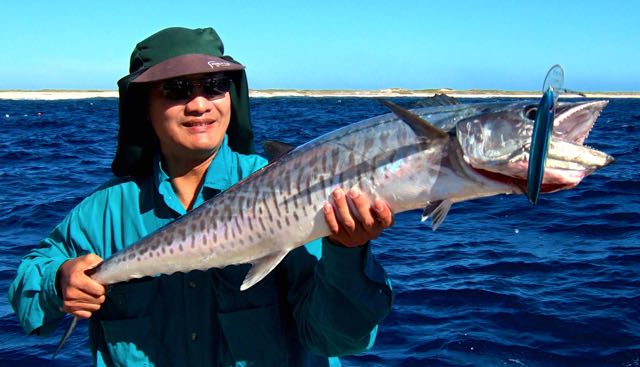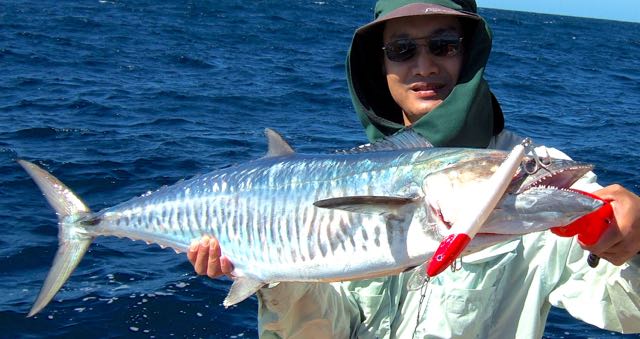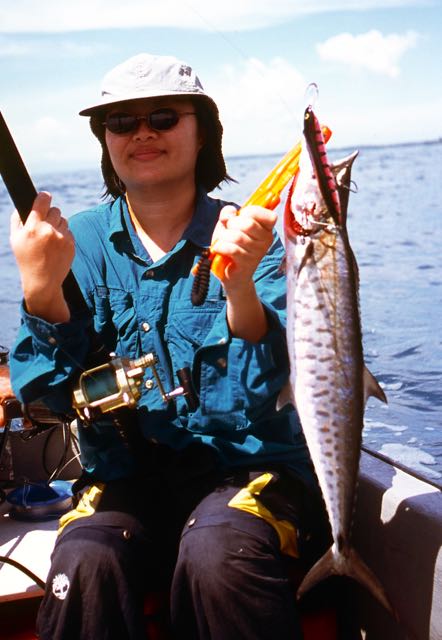
Lure
Trolling for Tenggiri (Narrow-barred Spanish Mackerel)
By Christopher S.G. Tan
Tenggiri batang, a.k.a. the Narrow-barred Spanish mackerel (Scomberomorus commerson) is a sought after pelagic species by Malaysian anglers for the sport and its good eating quality. There are various methods of catching them by angling, including the use of dead-bait, live-bait and artificial lures. In this two-part article I will look at the artificial lure methods I am familiar with.
A common tried-and-true method is trolling. Tenggiri often roam around, patrolling the areas holding food. Trolling lets the angler cover a big area; large areas of reefs, drop-offs and FADs - anywhere they might find forage.
Trolling requires lures that can track true at medium to high speeds as open water trolling is not done at a snail's pace. The lures also need to be able to track true in turbulent currents and wavy conditions. There are various good lures on the market that do this well.
The tenggiri can be found where the food is, so that is where one should troll, be it a wide ranging area where the lures are trolled along the drop-offs or reefs where baitfish gather or a smaller area like a rock outcrop/point or an FAD.

This tenggiri was caught by trolling a large 19cm Halco Laser Pro 190.
The lure to be trolled is selected based on the depth of the structure or seabed and the depth of the baitfish schools. You do not want the lure to get snagged on structure or seabed and lose it. Getting the lure to run at the depths of the schooling baitfish will put the lure in the feeding zone of the tenggiri. Most predatory fish often hang below or at the same level of the baitfish school so is pointless trolling the lure well above the baitfish school.
If I am trolling with light saltwater tackle (i.e. bait-cast tackle or light saltwater spinning gear), at the most I will use a lure that dives up to 4m. I find that deeper divers (big bibs/lips) have very heavy drag and put an immense strain (bend) in the light tackle rod, making the rod very tiring to hold in a small boat.

Pelagics
like tenggiri love any shiny lures like these Halco Sorcerer
90s (9cm in length) in different colour schemes with a chrome
base. These lures are equipped with Mustad Inline Singles size
2/0 hooks.
For deeper diving lures like those 8m deep diving lures that create a heavy drag, stronger boat/trolling rods with overhead reels or similar strength spin reel and rod set ups are more appropriate. These can be left in the rod holders for less fatiguing fishing instead of holding on to them.

Where
possible, the lure size and colour should be matched with the
baitfish that the tenggiri are likely to be feeding on. I have
found that the shiny chrome lures with colour tones similar to
the baitfish seem to get more strikes consistently. That is
not to say that a lure of a very different colour to the local
baitfish is not effective. It sometimes can work when the
normal colours do not, but I normally put out a “natural”
colour first.
I found that the chrome colours tend to get fish like tenggiri, whereas bright solid green, red, yellow and blue colours similar to those found on reef-fish will more likely hook up reef-fish like snapper and grouper type species. If there are several lures being trolled, do vary the colours, then concentrate on using what gets the most consistent strikes if a pattern emerges.

My
favourite colour patterns to catch tenggiri are these natural
looking colours of chromed finish with bluish tones or a mix
of colours. Interestingly for offshore fishing (Papua New
Guinea and Sarawak, Malaysia) this magenta/purple ("chrome
pink") tone consistently out-fished all other colours for
tenggiri.
I have caught tenggiri on trolling using lure sizes from 7cm to 19cm. The size that works best generally correlates with the size of the forage they are feeding on. A larger or much larger lure can work too, as the tenggiri might want a larger meal if it thinks it is worth the bite, or maybe it strikes them just out of plain aggression.
Trolling
speeds for tenggiri would be predicated by the lure types.
Generally tenggiri like a high vibration lure with a tight
action, not a slow lure that shuffles along. So lures that can
be trolled at a fast pace without blowing out of the water
work best, because at the higher end of their trolling range
speed they vibrate hard at a high frequency.

Not
all tenggiri are caught by fast trolling, this tenggiri was
caught slow trolling (2 knots) a tight actioned small Halco
Hamma 85 (8.5cm).
For
some lure types, trolling at 4 to 6 knots works well, but
tenggiri which are known for speed will readily hit lures
trolled at 8-10 knots and even higher speeds. Lures that can
troll at higher speeds are generally bibless lures or high
speed jet skirts/feathers. Here is a link to an article about
a small bibless lure I use for tenggiri – the
Halco Max 110.
The second part of this article covers lure casting and jigging.
Conservation


We need to protect and conserve our resources by practising catch and release of our sportfish and protecting the habitat of our fishes.








